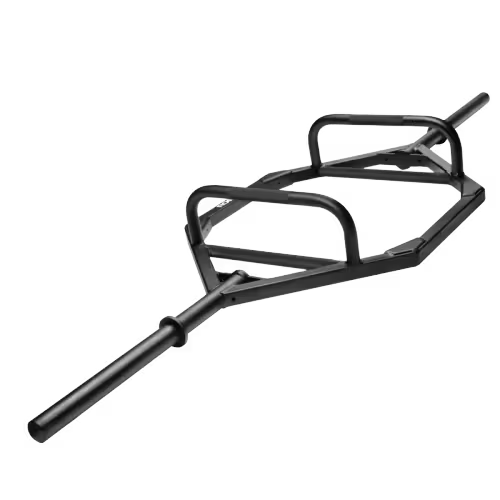11 Trap Bar Exercises for You
If you are new to the gym and have seen a trap bar or hex bar but need to know what it’s for, you are in the right place to learn about it. The trap bar can be used instead of a standard barbell for almost any barbell-based workout.
This unusual piece of gear is ideal for a comprehensive physical training program and comes with many other advantages. Here, we talk about the benefits of trap bar exercises and the best ways to work out to build muscle mass anywhere on your body.
Trap bars are popular exercise equipment due to their unique design. You can squat, push, row, and carry it without discomfort. If you have been lifting classic barbells for years, trap bar exercises could be a great alternative. Here is a list of some of the many ways you can have trap bar workouts.
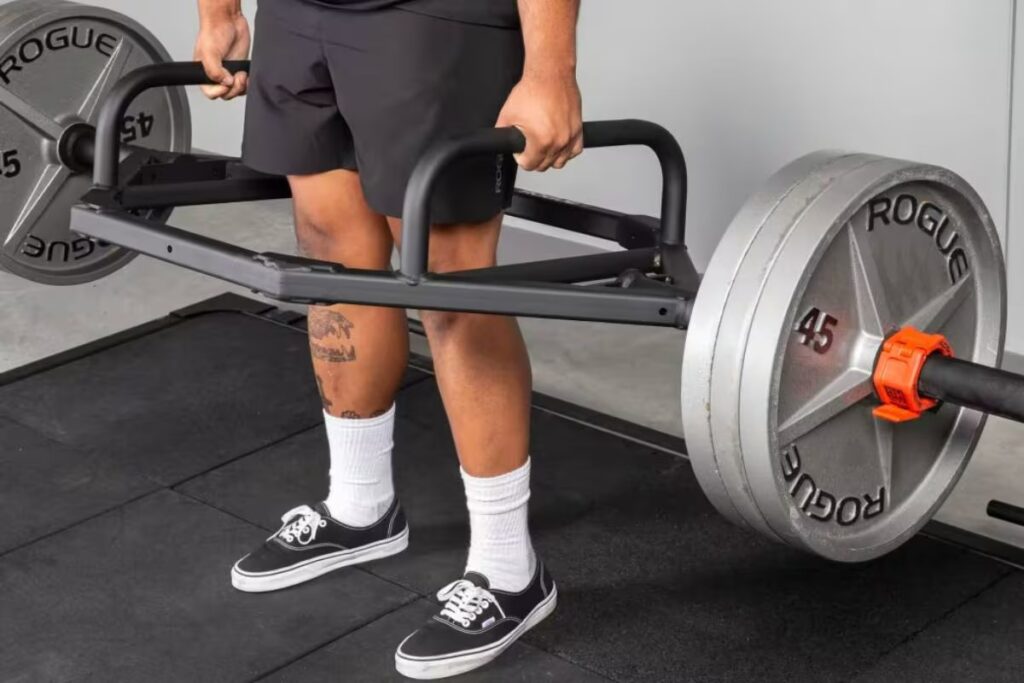
Trap Bar Exercises
The trap bar deadlift is the most iconic version among other exercises with trap bar. It is really the whole point of the trap bar.
The trap bar jump is another powerful exercise you can do. This action causes you to lift your body off the ground, much as when you leap.
Remember that because of the position of the grips, the trap bar bent over the row is less stressful on the lower back. Yet another trap bar workout is called the “Trap Bar Tall-Kneeling Shoulder Press.”
Even though there are many good trap bar workouts, we have put together a list of our favorites to help you with your training.
1. Trap Bar Deadlift
As a starting point, the traditional deadlift is an excellent full-body workout. Your back and shoulders will get a workout along with your legs.
Since it works simultaneously for so many muscle groups, the deadlift is one of the best exercises for building muscle.
The trap bar deadlift can help experienced weightlifters improve their barbell deadlift technique. It is another option if you are concerned about injuries. This exercise’s limited range of motion can reduce lumbar spine pressure while lifting heavy things.
How To Do it?
Your feet should be shoulder-width apart when you walk within the trap bar.
- Squat down and grab the trap bar’s grips while in the beginning position. Keep in mind that you should be clutching the bar right in the center.
- The next thing to do is to draw down on your shoulders so that they aren’t carrying the whole weight of your upper body. Keep your chin up, chest out, and back completely straight.
- The next step is to heave the load. Stand up tall when the trap bar reaches just above your knees by driving through your feet.
- Put as much restraint as possible on bringing the load down. Wait for a second or two after putting the weight back on the floor before attempting another repetition.
2. Trap Bar Jump
It is quite similar to a trap bar deadlift, except that the final extension is much more forceful. Like a leap, this action forces your feet to leave the ground.
This basic yet effective heavy-weight power training action boosts athletes’ raw strength. Due to their technical difficulties, Olympic lifts are often done improperly. Fortunately, this workout makes muscle gaining simpler.
How To Do it?
- You may put up the Trap Bar on the ground and brace yourself like a deadlift before leaping.
- Upon landing, you can “dump” the weight and allow the burden to pull them back into position. It prevents the muscles, joints, tendons, and ligaments from overworking.
- When doing a lightweight Trap Bar Deadlift, you must slow the bar and decelerate at the peak of the exercise to halt.
3. Trap Bar Bent Over Row
The bent-over row is an excellent workout to strengthen your lats and upper back. In addition, folks who suffer from back discomfort might benefit from doing this exercise.
The raised handles reduce the strain on your hip flexors and lower back compared to a traditional barbell row. The bar’s design makes it simple to see whether you are making a move correctly.
Not only will this help your back and posture, but it will also improve your form. A neutral grip allows you to keep your elbows closer to your sides, making it easier on your elbows. The load on your elbows will be reduced compared to regular rows.
How To Do it?
- Place your feet shoulder-width apart and stand in the middle of the trap bar.
- To reach the handles, you should now lean forward from the hips.
- Keep your chest and back straight and your butt pushed back while hanging on to the trap bar’s grips.
- Pull the bar up using your back muscles. At the peak of each rep, pause for a full second before releasing. Feel the burn in your lats by squeezing them slightly while doing this exercise.
- Finally, lower the bar carefully to complete the rep.
4. Trap Bar Squat
A trap bar can be used in place of a barbell for a weighted squat. Using trap bar rows while squatting, you may strengthen your whole body.
Even with limited shoulder mobility, this exercise is safe. Rolling a towel around the bar might provide padding between your upper back and the support.
How To Do it?
- Start by placing one foot within the trap bar while the other rests flat on a seat.
- Lean forward and squat.
- Grab the D-shaped handles.
- Bring the back bar up to your thigh by squatting.
- Bring the bar down slowly, stopping just before they hit the floor.
- Squat over and over until your muscles get tired.
5. Trap Bar Farmers Walk
The farmer’s walk is an excellent example of functional strength-training activity. Training this way is ideal for picking up several weeks’ worth of food in a single go. The process is simple and uncomplicated.
When compared to a standard farmers walk with a kettlebell or dumbbell, this full-body workout allows you to put more weight onto the lift. Trap bar lifts will make grip strength training easier than dumbbells.
How To Do it?
- Put the right amount of weight on the trap bar and go through it.
- Get a hold of the trap bar’s top handles.
- For the most part, you will need to do a deadlift to raise the bar so you can move on.
- As soon as the bar is up, you can move forward. Remember to walk straight and not slouch. Stand tall and put your chest out. Take your time and concentrate on baby steps.
- Keep going until you get there, or the timer runs out. Then, slowly and accurately reduce your weight.
6. Trap Bar Suitcase Carry
Carrying a suitcase with one hand is a fantastic exercise for strengthening your grip and core. There are tangible uses in daily life as well.
Consider how often you must handle a hot coffee and a long shopping list in one hand. Since the trap bar distributes weight less centrally, doing this will be more challenging than other hex bar exercises.
How To Do it?
- For a head start, the trap bar can be set up on end.
- The plate must be loaded at both ends. Get a good, solid hold on the bar’s midsection.
- Raise the bar. Stand with your feet hip-width apart and your shoulders back and level.
- Keep your head up and your shoulders back as you walk slowly.
- The trap bar should be lowered when the time or distance has passed.
- Put it down on your thigh. Turn around while holding on with one hand.
- Repeat
7. Trap Bar Overhead Press
The overhead press is a shoulder-defining upper-body exercise. Shoulder injuries may occur from doing this exercise improperly. That’s why a trap bar might be helpful to do this workout effectively.
The overhead press is better with a trap bar because the grip keeps the shoulders in a natural position.
How To Do it?
- You should use a power rack or similar to load the trap bar. Why? Doing this trick at shoulder height will take a lot of work.
- You must then enter the trap’s inner bar.
- Put your hands where the handles are and keep them there.
- Take a deep breath, tighten your grip on the handles, and brace yourself. Now, raise the bar to the locked position. Lockout and take a deep breath when you reach this stage.
- Bring down the bar as gently as you can. If the tension on the bar is released too quickly, someone could get hurt.
8. Trap Bar Floor Press
The trap bar floor press has many of the same benefits as a regular one. But the most significant advantage of using a trap bar floor press is that it stops the shoulders from rotating.
How To Do it?
- Rest while the trap bar is connected to the power rack. In this case, you can use either the end of the bail bar or the lowest rung of the rack.
- Grab the neutral handles of the trap bar. Knees should be bent, and feet should be flat on the floor.
- Raise the barbell from the rack, do a press, and then lower the weight gradually. You should avoid banging your elbows on the ground at all costs.
- The last step of a rep is to push the bar back up. Repeat as often as necessary.
9. Trap Bar Figure-8 Carry
A trap bar can hold far more weight than any set of dumbbells or kettlebells. It means that you can gain muscle mass and get a firmer grip.
In a packed gym, it helps you to get more work done in less room. The figure-eight movement also tests your balance and coordination, which is a bonus.
How To Do it?
- Get into a deadlifting position.
- Raise the load on your shoulder.
- Try not to rush as you go out on your stroll.
- Follow a figure eight path.
- Keep your head and shoulders down and your chest high.
10. Trap Bar Push-up
The trap bar push-up is a novel way to strengthen the pectoral muscles and the biceps. To increase the difficulty of balancing on the trap bar, you may add weight to it.
How To Do it?
- Place a trap bar on the floor with nothing in it.
- Put your hands on the grips and go into a push-up posture.
- Do a simple push-up now.
11. Trap Bar Rack Pull
The trap bar rack pull strengthens the lower back and the remainder of the posterior chain. It is a version of the rack pull.
The trap bar high pull can be used to work on a lifter’s lower back.
How To Do it?
- Place the bar on the safety pins in the rack to be just below the knees.
- As you take a stance, keep your hips inside the trap bar.
- Bring your hips back to hinge forward. Stretch your arms down and grab the handles with a relaxed grip wider than your shoulders.
- Take a deep breath in and slightly pull up on the bar. As you let your breath out, let your hips drop in a seesaw motion.
- Use your entire foot to press down and away from the floor.
- Maintain a straight line from knee to hip as you stretch the bar.
- When you are ready to unhinge, lock out your hips and then push them back while hinging forward.
- Put the bar back on the pins, reset, and do as many reps as you want.
When and Why to Use a Trap Bar?
The main goal of the hex bar workouts is to make deadlifting easier and lessen the strain on the lower back. This deadlift version is suitable for beginners because the weight is in the middle. This makes it easy to fix your form and work the right muscles.
1. It’s Easier on the Spine
The trap bar is made to be different from a standard barbell. There are two key distinctions:The first is that the body’s weight is distributed evenly.
The sleeves are set immediately to the sides since you walk into the bar. The trap bar brings the weight closer to your body’s center of gravity than a conventional barbell does while lifting.
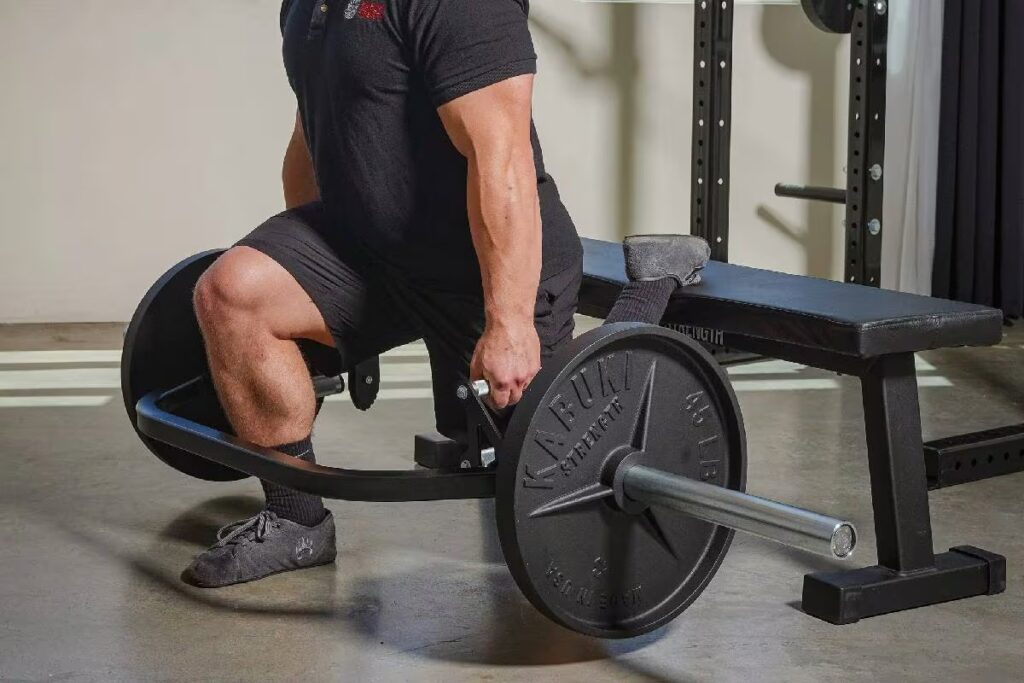
2. Versatility
The versatility of the hexagon bar workout is one of its main selling points. The trap bar can be used for many exercises, like the deadlift.
The trap bar’s adaptability also stems from the weight’s placement on the bar. Unlike barbells, trap bars can be used with the same weight on both sides.
3. Ease Your Shoulder Pressure
Shoulder and scapular problems and injuries are common among weightlifters. Because of this, doing deadlifts with a straight barbell could hurt. The trap bar is much more comfortable to use than a regular barbell.
Remember that with trap bar side grips, your shoulders and neck won’t hurt as much when you do deadlifts and similar moves. It creates room between your shoulder blades to facilitate movement.
4. Gain Significant Power
The Trap bar is the best way to get more robust and muscular. Several evaluations have shown that the trap bar deadlift is better than the straight bar deadlift.
5. You Can Carry More Weight
People who have tried trap bar deadlifts say they can lift more weight than when they use a regular barbell. The weights on this barbell are on the side, which is different from a standard barbell.
The trap bar allows users to lift more weight, increasing muscle mass and strength.
6. Grip Stability
People often forget to train their grip power. The trap bar can help strengthen your grip.
First of all, remember that it works well for tight static grips. The ability to carry big objects is another benefit of the trap bar.
Even though a trap bar with an open end is better, you can still walk on some closed trap bars that are wide enough. Keep in mind that there are now different grips on each of the trap bars.
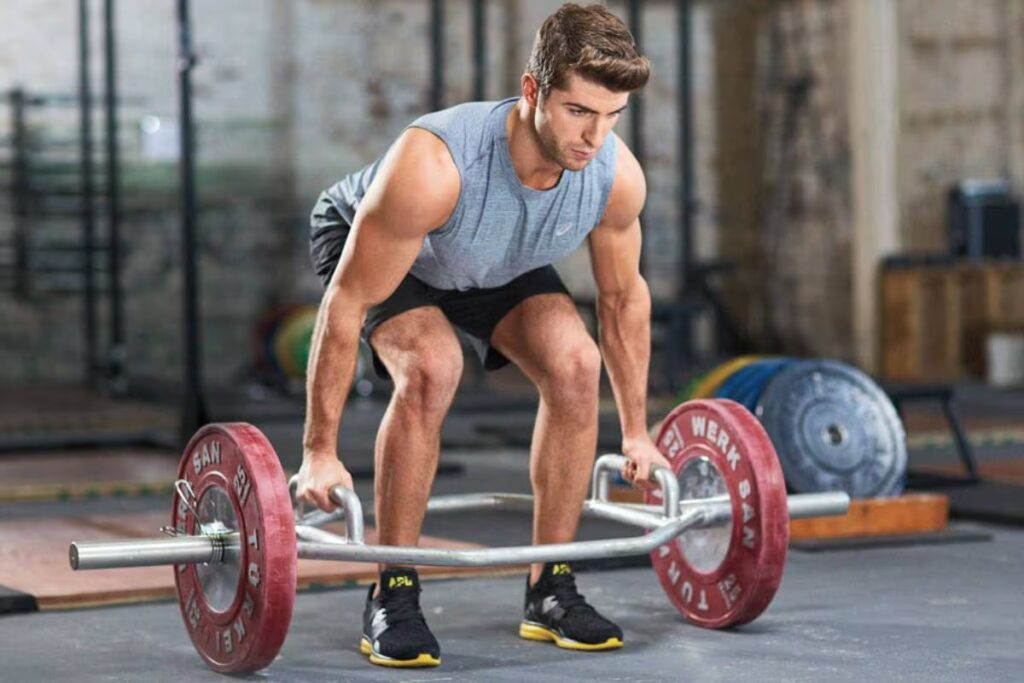
Trap Bar Workouts
We have discussed two trap bar workouts to help you get in shape. Make sure you have everything you need before starting your trap bar workout routines.
Note: Do the exercises in the order they are listed. It gives you enough time to rest between sets. After you finish a workout, rest for two to three minutes and then do two or three more sets.
1st Workout:
- Six to ten jump squats
- Push-ups, 10-30 reps
- Farmer’s Carry for 20-40 meters
- Ten repetitions of shrugs
- 8-12 repetitions of Bent Over Row
- 10-12 repetitions of the floor press
- 6-8 repetitions per side in a staggered stance deadlift
2nd Workout:
- Deadlift using a trap bar 2-3 sets of 6-8 repetitions
- 2-3 sets of 8-12 repetitions on the floor press
- 2-3 sets x 20-40 meters of Farmer’s Carry
- 6-8 repetitions of jump squats
- 2-3 sets of 8-12 repetitions bent-over row
- 2-3 sets of 6-12 repetitions overhead press
- Aim for 2-3 sets of 6-8 repeats of the staggered stance deadlift on each side.
Trap Bar We Recommend – ROGUE TB-2 TRAP BAR
For legitimate reasons, one of our favorite trap bars is the Rogue TB-2. It’s a high-quality, no-frills trap bar with a single-handle design and other good touches, like being accepted for use in the Army CFT.
Features & Highlights
- The Rogue TB-2 Trap Bar has two grips for full and half lifts. The handle is 8.25 inches from the ground.
- There are 25 inches of spacing between the handles, which is plenty of room for many users and an excellent shoulder-clearing distance.
- The rackability of this bar gives you more options.
- The TB-2 has a loadable sleeve length of 16 inches. The upper end of the trap bar range makes it comparable in size to a standard barbell.
- Specialty bars often include a powder coat finish. It prevents rusting well but it shows scratches and scuffs rapidly, particularly at the sleeve and rack interface.
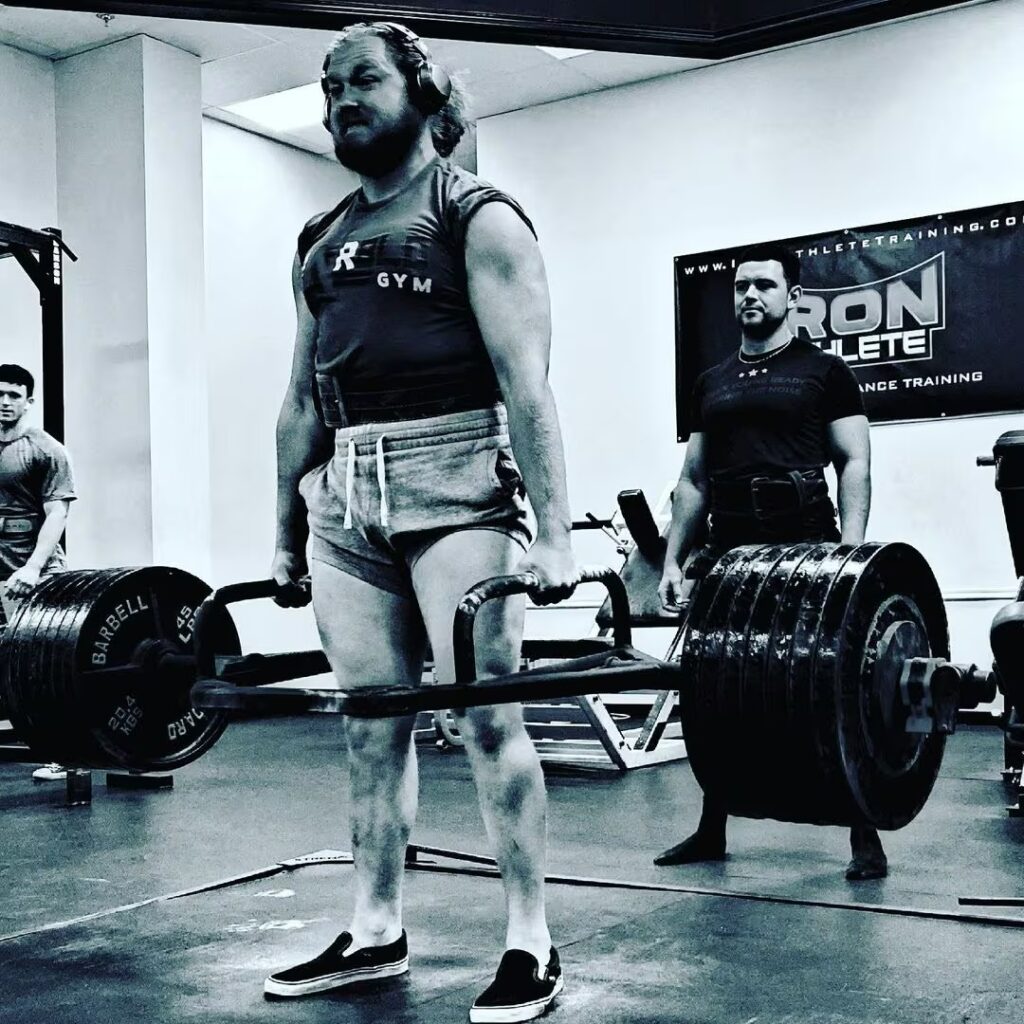
Who Needs a Rogue TB-2 Trap Bar?
- This trap bar is preferable to using a barbell when doing deadlifts since it allows for better shoulder alignment with the handles.
- The TB-2 is a trap bar that can be used for multiple things. Customers usually use it for bench presses and shoulder presses.
- This trap bar’s loading sleeves are standard length so you can load it up with plenty of plates for a big lift.
Customers are quite satisfied with the Rogue TB-2 Trap Bar. It has an overall 4.8-star rating.
FAQ
Is Trap Bar as Good as Deadlift Bar?
The trap bar deadlift is quite similar to the barbell deadlift; the main difference is intensity. Even though the weights used in squatting and deadlifting are the same, most people can deadlift more weight when they use a trap bar.
Both deadlifts include hip hinges, but the trap bar deadlift has more significant peak knee moments. Moreover, the trap bar deadlift activates the hamstrings and spinal erectors less than the straight bar deadlift.
Is the Trap Bar a Squat or Deadlift Bar?
The terms “squat” and “deadlift” are often used interchangeably to describe the trap bar exercise. But if the movement starts on the floor, we’ll call it the “trap bar deadlift.”
It is because there is a type of squat called a trap bar squat in which the weight is racked at chest level, and the lifter squats.
To be clear, the trap bar squat is more like a deadlift than the squat. Why? Since the knees and hips don’t bend, the quadriceps and hamstrings get fewer workouts than they do in the back squat.
How Heavy is a Trap Bar?
Most trap bars (hex bars) weigh between 20 and 44 pounds (9 and 18 kilograms). Check the weight of your trap bar or hex bar before you figure out your rep max.
A trap bar can look like anything from a hexagon to the letter C. There are 45-pound and 65-pound bars available, with the bigger bar supporting greater weight.
Conclusion
As you can see, the trap bar can be used for various weightlifting exercises. Thanks to this invention, many workouts can be performed with less risk of injury and less strain on the shoulders and back.
Although the deadlift is where hex barbells really shine, you’d be surprised by how many other exercises they can be used for.
A trap bar is an excellent addition to your bar collection because of the vast range of workouts you can do with it. Choose any of the trap bar exercises we have listed above and write a comment or question about it below.
Also read:
- Best Barbells for Functional Fitness
- Trap Bar Deadlift
- Hex Bar Deadlift vs Barbell Deadlift
- How Much Does a Hex Bar Weigh
- Best Landmine Attachments
- Best Bumper Plates
- The Barbell Jack Review
- Best Barbell Collars
- How Long Is an Olympic Barbell
- Dumbbells vs Barbells
References:
- Should You Use a Trap Bar For Deadlifts? // Menshealth: https://www.menshealth.com.au/should-you-use-trap-bar/
- The top 8 benefits of deadlifts // Menshealth: https://www.healthline.com/health/fitness/deadlift-benefits#benefits
- What is grip strength, exactly? // Greatist: https://greatist.com/fitness/grip-strength#what-is-grip-strength
- How to Do Figure Eights // Verywellfit: https://www.verywellfit.com/how-to-do-a-figure-eight-4800976
- Straight barbell palms up wrist curl // Menshealth: https://www.menshealth.com/uk/fitness/a752934/straight-barbell-palms-up-wrist-curl/
- A case for the trap bar deadlift// Hertssportsvillage: https://www.hertssportsvillage.co.uk/news-a-case-for-the-trap-bar-deadlift-544
Why Trust Us?
With over 20 years in Olympic Weightlifting, our team does its best to provide the audience with ultimate support and meet the needs and requirements of advanced athletes and professional lifters, as well as people who strive to open new opportunities and develop their physical capabilities with us.
By trusting the recommendations of our certified experts in coaching, nutrition, dietology, and sports training programming, as well as scientific consultants, and physiotherapists, we provide you with thorough, well-considered, and scientifically proven content. All the information given in the articles concerning workout programming, separate exercises, and athletic performance, in general, is based on verified data. We ensure that you can rely on our professionals’ pieces of advice and recommendations that can be treated as personalized ones which will benefit you and fully meet your needs.
The product testing process is described in more detail here
Author: Ihor Shymechko
Pro Olympic Weightlifter, Coach
Best Results: Snatch – 208 kg,
C&J – 240 kg
Ihor has been a professional weightlifter since 1996, boasting over two decades of competition experience. His notable achievements include clinching the European Championship in 2009 and securing a silver medal in the 105kg division at the Senior World Championships in 2011. Ihor represented his country in the 2008, 2012, and 2016 Summer Olympics. After retiring from competitive weightlifting, he transitioned to coaching, leveraging his vast experience to guide athletes who now compete on both national and international stages.

